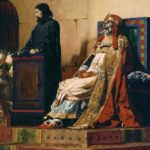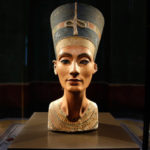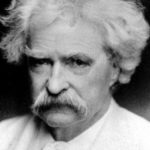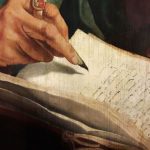 Creepy
Creepy  Creepy
Creepy  Movies and TV
Movies and TV 10 Amazing Lead Actor Ideas for Superhero Movies
 Our World
Our World 10 Crazy Facts about Cycads That Might Surprise You
 Technology
Technology 10 World-Changing Examples of Turning Dumb Technology into Smart Technology
 Pop Culture
Pop Culture Ten Celebrities Who Straight-Up Lied on Home Tours
 Animals
Animals 10 Remarkable Things We’ve Recently Learned about Animals
 Weird Stuff
Weird Stuff 10 Reasons the Psychic Internet Theory Will Blow Your Mind
 Movies and TV
Movies and TV Television’s Top Ten Most Ruthless Serial Killers
 Weird Stuff
Weird Stuff Ten of the Strangest Paraphilias Ever Documented
 Miscellaneous
Miscellaneous 10 Interesting Physics Facts about Bullets
 Creepy
Creepy 10 Unnerving Legends from Around the World
 Movies and TV
Movies and TV 10 Amazing Lead Actor Ideas for Superhero Movies
 Our World
Our World 10 Crazy Facts about Cycads That Might Surprise You
Who's Behind Listverse?

Jamie Frater
Head Editor
Jamie founded Listverse due to an insatiable desire to share fascinating, obscure, and bizarre facts. He has been a guest speaker on numerous national radio and television stations and is a five time published author.
More About Us Technology
Technology 10 World-Changing Examples of Turning Dumb Technology into Smart Technology
 Pop Culture
Pop Culture Ten Celebrities Who Straight-Up Lied on Home Tours
 Animals
Animals 10 Remarkable Things We’ve Recently Learned about Animals
 Weird Stuff
Weird Stuff 10 Reasons the Psychic Internet Theory Will Blow Your Mind
 Movies and TV
Movies and TV Television’s Top Ten Most Ruthless Serial Killers
 Weird Stuff
Weird Stuff Ten of the Strangest Paraphilias Ever Documented
 Miscellaneous
Miscellaneous 10 Interesting Physics Facts about Bullets
10 Little-Known but Fascinating Letters Between Famous Figures
In a world where instant messaging is everywhere, letter writing can seem positively ancient. But until recently, it was the best way to send a message over a long distance, and not much can compare with letters when it comes to learning about the lives of historical figures. For almost every famous person, an archive of their correspondence can be found.
As well as revealing things like opinions that they did not share in public, letters can show someone’s connection to others. And when it comes to the rich, powerful, and famous, there are plenty of interesting and unlikely pairings to be found. From people trying to persuade world leaders to secret fans and powerful pen-pals, here are ten little-known times when famous figures wrote to each other.
Related: Top 10 Fascinating Things Done By Dead Historical Figures
10 Einstein and Freud
It seems reasonable to think that getting some of the world’s brightest and most original minds to work together might provide solutions to some of the world’s most difficult problems, such as war. That was the idea of the International Institute of Intellectual Cooperation, which in 1932 sponsored an exchange of letters between the physicist Albert Einstein and the psychoanalyst Sigmund Freud.
Titled “Why War?” it began with Einstein seeking Freud’s insights about human psychology to see if there was any hope of world peace or whether violence was built into the human brain. The two went on to discuss the history of war, its role in politics, and their hopes for the League of Nations.
Sadly, the letters between these two leading thinkers did not lead to world peace. In fact, the exchange did not achieve the circulation it was expected to because it was published in 1933, the year that Hitler came to power. The Nazis were quick to try and discredit the work of the pair, who were both Jewish and pacifists.[1]
9 Gandhi and Hitler
Einstein and Freud were not the only pacifists putting their minds toward the prevention of another world war. A few years later, in 1939, Mahatma Gandhi put pen to paper from the other side of the globe. But he had a more direct approach—write to Adolf Hitler. It was a last-ditch attempt after an earlier effort to persuade Mussolini in person had failed. War was inevitable, and despite his rejection of colonial rule, Gandhi had no wish to see Europe reduced to rubble nor for India to become free because of the destruction of England.
So he felt that he had a moral duty to try and help avoid the conflict. He highlights to Hitler the “considerable success” he has achieved without resorting to war and asks him whether any object is worth the price of reducing humanity to savagery. Tragically, he was forbidden by the colonial government to send the letter. However, its apologetic tone suggests he knew what Hitler’s most likely response would have been. He did try again at the end of 1940 but with the same result.[2]
8 Henry Ford and Gandhi
Gandhi’s pacifist stance and the success of his civil disobedience campaign were admired from afar by an unlikely source—one of the world’s wealthiest men who was also manufacturing bomber planes for use in the Second World War. But Henry Ford had given in to government pressure to aid the war effort. It was his personal opinion that the USA should have stayed neutral. He was also no fan of imperialism, and with his cars selling well in India’s biggest cities, he had been keeping an eye on the country. Ford was so impressed by Gandhi that in 1941, he wrote to him to let him know, describing him as “one of the greatest men the world has ever known.”
Interestingly, Henry Ford had had a letter allegedly from a famous admirer a few years earlier. It was, however, likely to have been a hoax, and it was certainly not from a pacifist. A letter he received in 1934 was signed by the gangster and bank robber John Dillinger, praising Ford’s “excellent” cars, which the criminal was widely known to use.[3]
7 Churchill and H.G. Wells
So much has been written about Winston Churchill that it is hard to believe this flew under the radar until 2006, but he was actually a fan of science fiction. In particular, he favored the work of H.G. Wells, author of The War of the Worlds and The Time Machine, among many other stories. He used phrases from Wells in some of his most famous speeches and stated in 1931 that he could “pass an exam” on the popular author’s work. Wells might even have influenced Churchill’s politics, although that influence came chiefly from his non-fiction works like Anticipations, a book of predictions.
But Churchill enjoyed Wells’s fiction too—he criticized another of his books for being too thought provoking and too short on action. After publishing Anticipations in 1901, Wells’s publishers sent a copy to Churchill, who sent a letter back saying that he read everything Wells wrote. The following year, they met in person, and they wrote to each other until Wells died in 1946.[4]
6 Abraham Lincoln and Karl Marx
One might expect politicians to spend their spare time reading and speaking with thinkers and economists rather than science fiction writers. This was the case for Abraham Lincoln, but some of the thinkers he kept in touch with were surprising. Lincoln was not a socialist or communist, but he read the works of and even corresponded with Karl Marx. The two were actually only born nine years apart and shared a friend called Charles Dana.
As managing editor of the New York Tribune, Dana hired Marx as the paper’s British correspondent. Dana later left the Tribune to become an adviser to Lincoln during the U.S. Civil War. Marx wrote to Lincoln in 1865 to congratulate him on being reelected and for fighting to end slavery. Lincoln responded via the U.S. ambassador to Britain, expressing that he considered Marx and his followers “friends.” The exchange was printed in newspapers on both sides of the Atlantic, and Marx was thrilled that it had the bourgeoisie “shaking their heads.”[5]
5 Mary Todd Lincoln and Queen Victoria
After Abraham Lincoln was assassinated, the spotlight fell on his grieving widow, Mary Todd Lincoln. The people wanted to see whether she could pull herself together and behave like a proper lady under the circumstances. By 19th-century standards, that meant displaying no emotion in public. Mary, who is now believed to have suffered from poor mental health and was possibly bipolar, could not. Word leaked out from the White House that she was regularly wailing, shrieking, and writhing around in emotional turmoil. To her countrymen, her actions were seen as attention-seeking, but not everyone was so lacking in sympathy.
In April 1865, she received a warm, handwritten letter of condolence from a fellow widow across the pond—Queen Victoria herself. The British monarch, who described herself in the letter as “utterly broken hearted” by the loss of her own husband in 1861, had never met the First Lady. Still, she explained how she felt unable to stay silent while Mrs. Lincoln was faced with such a tragedy. The letter breaks with the cold “stiff upper lip” attitude that Queen Victoria’s name usually invokes.[6]
4 Catherine the Great and Voltaire
Another empress who corresponded with people far removed from her country and social circle was Catherine the Great of Russia, who was for many years a pen pal of the influential French philosopher and author Voltaire. The two conducted their entire relationship via letters, never actually meeting in person. When Catherine became empress after her husband Peter III’s death, she promoted the arts and is said to have seen herself as something of a philosopher.
This encouraged her to seek out the great minds of her day, and some, like Voltaire, already admired her and were more than willing to respond. Despite her authoritarian style of rule, Voltaire viewed her favorably in comparison with the French monarchy. In fact, he admired her so much that he even had a portrait of her in his bedroom.
The pair exchanged 26 letters, which have been described as “intimate” rather than diplomatic. The contents of the letters only became known in 2006, when a Russian art dealer purchased them from a private collection in Paris for €583,200.[7]
3 Elvis and Richard Nixon
It takes a certain level of fame and influence for a hastily scrawled letter on a bit of airline notepaper to score someone a meeting with the American president. But in 1970, Elvis Presley had reached that level. After flying to Washington D.C. in December of that year, the king of rock n’ roll delivered his letter to the White House and, just a few hours later, found himself in a room with President Richard Nixon.
Elvis’s goal was to get hold of a badge from the Bureau of Narcotics and Dangerous Drugs to add to his collection of police badges. To get this, he needed federal agent credentials, so in his letter, he appealed to the man with the most power to grant them to him.
Elvis wrote to Nixon about his love for his country, how he could communicate with anti-establishment groups because they did not see him as an enemy, and how he had studied drug abuse and communist brainwashing techniques. When they met, Elvis presented Nixon with a pistol as a gift, and in return, he was given his badge.[8]
2 J. Edgar Hoover and Martin Luther King Jr.
Anyone championing social change can expect to come up against challenges and underhand tactics, and civil rights leader Martin Luther King Jr. was no exception. One challenge he faced came in the form of a letter. Although anonymous, it was known to come from the FBI. At that time, the bureau was under the command of J. Edgar Hoover, who had the FBI monitor King, including wiretapping his home and office.
After having captured evidence on tape of his extramarital affairs, they sent King the tape along with an anonymous letter which denounced him as “evil,” “a colossal fraud,” and accused him of “immoral conduct lower than that of a beast.” The tone and language of the letter went further than simply attempting to discredit or embarrass King; the Senate Select Committee later interpreted it as an effort to get King to commit suicide.
King was not convinced and, in a stroke of luck, the FBI had misjudged the media climate of the times. The press wanted nothing to do with the letter, and its contents did not become public until a decade later.[9]
1 Alexander Graham Bell and Helen Keller
While his most famous invention was sound-based, the inventor Alexander Graham Bell was extremely sympathetic toward the deaf. In fact, when he was older, he reflected that his work with the deaf pleased him more than his fame as the inventor of the telephone. While some of his methods have been criticized, his friendship and support of the deaf-blind author Helen Keller is evidence of how much he cared.
Bell first met her in 1886, while Keller was still a child, and supported her throughout her life. She was a regular guest in the Bell household, and he often sent her money as well as established a trust fund that paid for Keller’s education at the prestigious Radcliffe College. Around 1900, Bell learned how to use a braille typewriter so that he could write letters to Keller himself. This impressed Keller, who replied to his first attempt at a braille letter by writing that she had not found any mistakes and that it was almost as if he had clasped her hand in his.[10]








